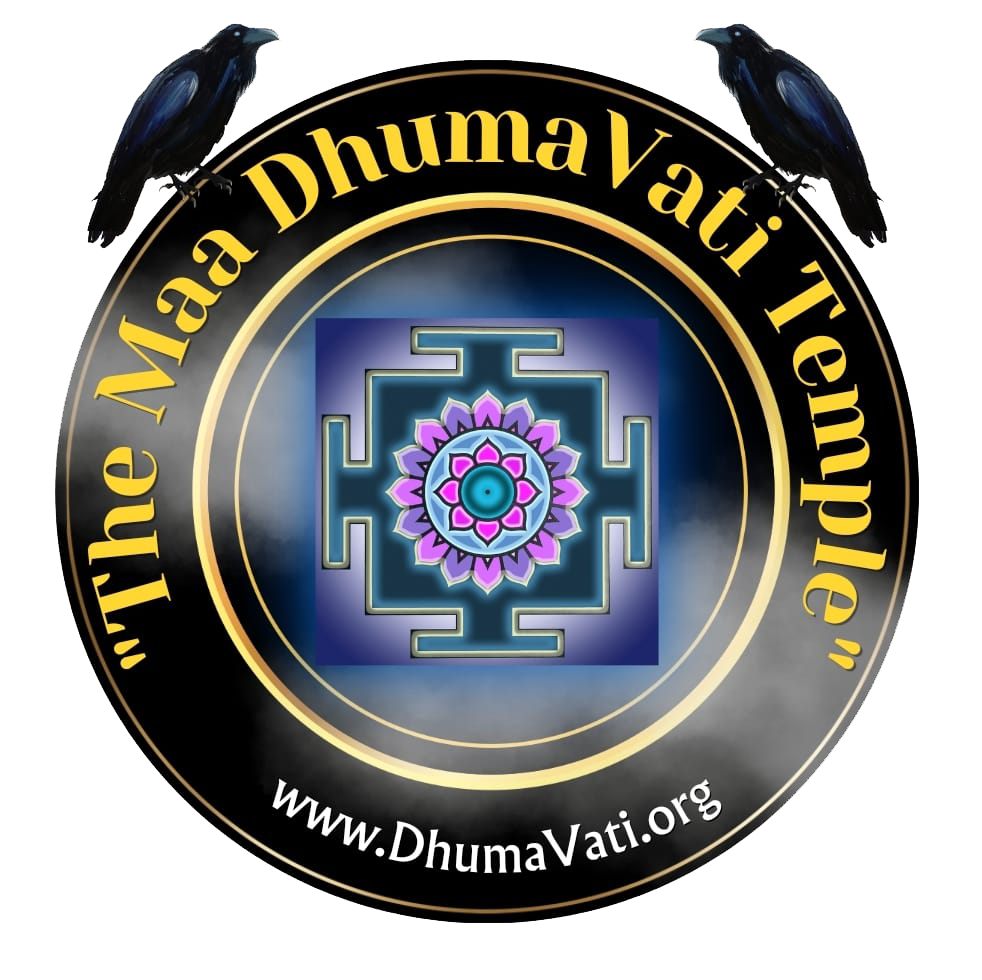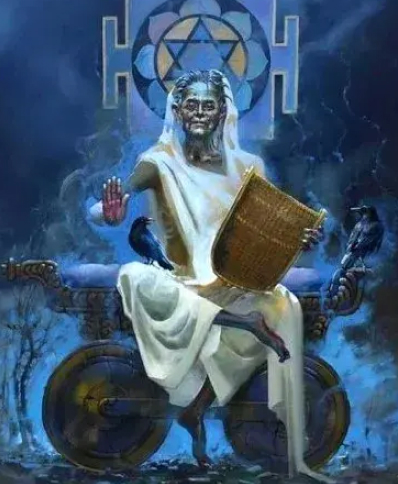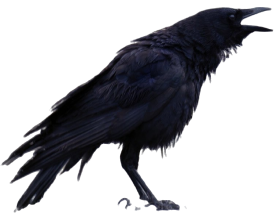
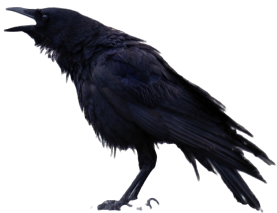
The Divine Mother Maa DhumaVati
History of worship Of "The Divine Mother Maa DhumaVati"
History of worship Of
"The Divine Mother
Maa DhumaVati"
The Divine Mother, Maa Maha Kaali, As Maa DhumaVati Is Revered As The Embodiment Of Divine Blessings in disguise. The Dark, Shadowy, And Smoky Depiction Of Maa DhumaVati Symbolizes being able to overcome challenges of life, such as overcoming disappointment, frustration, humiliation, defeat, loss, sorrow, and loneliness With Divine Mother’s Blessing. The Divine Mother Is Ever-Present, both in auspicious moments and in situations often considered inauspicious or negative by society due to lack of their wisdom.
Maa DhumaVati Guides Blesses devotees with realization that adversity and challenges are transformative experiences. By Blessings Of Maa DhumaVati, deserving devotees are Enabled to recognize The Blessings of The Divine Mother In both the light and darkness of life.
Maa DhumaVati Blesses devotees to learn from challenging aspects of life, with such experiences serving as unique opportunities to learn to overcome worldly desires and to “transcend”. The Divine Mother Maa DhumaVati Blesses devotees with patience, perseverance, forgiveness, and detachment upon those courageous devotees who embrace these experiences.
History Of Worship Of Maa DhumaVati
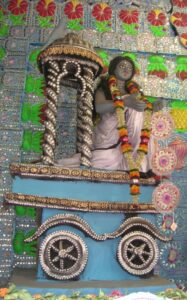 The earliest records of worship Of Maa DhumaVati can be found in tantric texts from the 9th and 10th centuries CE, such as tantrasara and tantraloka. History of worship Of Maa DhumaVati Is steeped in deep esoteric practices, blending myth, philosophy, and ritualistic worship.
The earliest records of worship Of Maa DhumaVati can be found in tantric texts from the 9th and 10th centuries CE, such as tantrasara and tantraloka. History of worship Of Maa DhumaVati Is steeped in deep esoteric practices, blending myth, philosophy, and ritualistic worship.
These texts provide insights into tantric sadhana (spiritual practice) focused on worship Of Maa DhumaVati, with expectation of transcending material desires, illusions, and attachments by seeking Blessings From The Divine Mother Maa DhumaVati. Historically, tantric sects worship Maa DhumaVati, often those following left-hand path (vamachara) rituals.
These esoteric practices often involved confronting and integrating the darker aspects within oneself.
Formalization Of Worship
By the medieval period, particularly between the 12th and 15th centuries, the worship Of Maa DhumaVati became more formalized in parts of india.
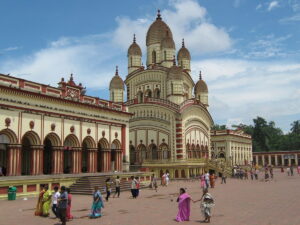 Temples dedicated to the worship Of Maa Das MahaVidyas, including temples for the worship Of Maa DhumaVati, began to appear, though they were fewer compared to those dedicated to the worship Of Different Divine Forms Of Maa Maha Kaali.
Temples dedicated to the worship Of Maa Das MahaVidyas, including temples for the worship Of Maa DhumaVati, began to appear, though they were fewer compared to those dedicated to the worship Of Different Divine Forms Of Maa Maha Kaali.
The worship Of Maa DhumaVati remained mostly within tantric circles and certain sects of “Shakta” devotees. During this period, worship Of Maa DhumaVati was closely linked to renunciation and detachment.
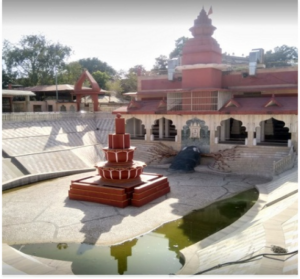
In bengal and northern india, particularly within tantric communities, devotees seek Blessings Of The Divine Mother Maa DhumaVati to overcome obstacles, ego, and to achieve spiritual liberation(moksha).
Only recently, in this mature age of kalyug, as realization of the dissolution of the illusion of reality and life comes to the forefront of human consciousness, collective awakening takes shape towards worship Of The Divine Mother Maa DhumaVati.
First Myth – Self-Immolation By “Maa Sati”
According to first myth, Maa DhumaVati Emerged when Maa Sati Self-Immolated In Her father’s sacrificial fire. Maa DhumaVati Arose From Smoke Of Maa Sati’s Burning Body, Embodying Both The Energy Of The Indignant Maa Sati During Self-Immolation And Funeral Smoke.
Second Myth
Second Myth recounts an incident where Maa Sati, Residing With lord shiva In the himalayas, Grew Extremely Hungry And Asked him for food. When lord shiva refused, Maa Sati Threatened To Consume him, And Indeed Swallowed him.
This literal Myth has a a deep esoteric meaning, which have Multiple Hidden ‘Wisdom’ associated.
Maa Sati And Lord Shiva are considered As One Whole, and The “Swallowing” Depicts Oneness Where Maa Sati Grew Hungry For Food Symbolizing The Desire Of “Shakti” To Merge with “shiva” – and in the end Maa DhumaVati – Symbolized As Smoke – Depicts The Result And Regression Of “Shiva” And “Shakti” Into The Primordial Form – “Maa DhumaVati”.
Afterwards, when lord shiva convinced Maa Sati To Release him, Maa Sati Transformed Into Widow Form – As The Divine Mother Maa DhumaVati.
This Symbolizes Transformation Through Attaining Oneness Of The Divided Forms Of The Divine – “Shiva” and “Shakti” – solitariness leading to spiritual liberation.
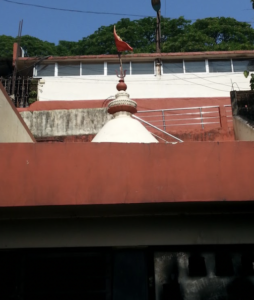
Temples And Pilgrimage Sites
Varanasi: The “Maa DhumaVati Temple”
Among the temples for the worship Of Maa DhumaVati, notable is The “Maa DhumaVati Temple” in varanasi, india, a significant pilgrimage site and hub of tantric practices associated with the worship Of The Ten Cosmic Wisdom Forms Of The Divine Mother – As Maa Das MahaVidyas. The temple is small and secluded, reflective of esoteric nature of worship, and attracts mainly tantric practitioners and sincere seekers.
In madhya pradesh, india, tantrics perform rituals seeking Blessings From The Divine Mother Maa DhumaVati.
Maa KamaKhya Temple Complex In Guwahati, Assam: “Shakti Peeth”
In the “Maa KamaKhya Temple Complex” area, The “Maa DhumaVati Temple” is dedicated for the worship Of The Divine Mother Maa DhumaVati, and is a special place of worship, meditation, and transcendence.
Such temples and sacred sites hold immense importance for devotees to submit To The Divine Mother Maa DhumaVati.
Conclusion
The worship Of Maa DhumaVati has historically been associated with those on the fringes of mainstream practices, particularly within the tantric tradition. From early tantric texts to present-day temples dedicated to the worship Of The Divine Mother Maa DhumaVati, devotees flock seeking Blessings From The Divine Mother Maa DhumaVati, seeking understanding and embracing life’s darker, inevitable truths for finding The “True Self” beyond the illusions of life’s maya, and attaining liberation.
The Divine Mother, Maa Maha Kaali, As Maa DhumaVati Is Revered As The Embodiment Of Divine Blessings In Disguise. The Dark, Shadowy, And Smoky Depiction Of Maa DhumaVati Symbolizes the challenging aspects of life, such as disappointment, frustration, humiliation, defeat, loss, sorrow, and loneliness.
The Divine Mother Is Ever-Present, both in auspicious moments and in situations often considered inauspicious or negative by society due to a lack of wisdom. However, since most people remember and pray To The Divine Mother Maa DhumaVati, in moments of loss or suffering they mistakenly associate The Divine Mother Maa DhumaVati, with darker aspects of life.
Maa DhumaVati Guides deserving devotees to realize that adversity and challenges are transformative experiences. By Blessings Of Maa DhumaVati, deserving devotees are Enabled to recognize The Presence of The Divine Mother In both the light and darkness of life.
Maa DhumaVati Blesses devotees to learn Great Wisdom from the challenging aspects of life. Such experiences serve as unique opportunities to overcome worldly desires and to connect With The Ultimate Reality Beyond them.
Recognizing The Presence Of The Divine Mother And The Valuable Lessons Hidden Within these negative experiences Is A Great Blessing Of Maa DhumaVati Upon devotees.
Maa DhumaVati Bestows virtues such as patience, perseverance, forgiveness, and detachment upon those courageous devotees who embrace these experiences. By The Blessings Of Maa DhumaVati, devotees are transformed into great teachers for humanity, sharing the wisdom learned through their life lessons.
Myths and Origins
The history of the worship Of Maa DhumaVati Is steeped in deep esoteric practices, blending myth, philosophy, and ritualistic worship. There are two key Myths associated With “Maa DhumaVati”.
The First Myth
According to the first Myth, Maa DhumaVati Emerged when Maa Sati Self-Immolated In Her father’s sacrificial fire. Maa DhumaVati Arose From The Smoke Of Maa Sati’s Burning Body, Embodying Both The Energy Of The Indignant Maa Sati During Her Self-Immolation And The Funeral Smoke. This Myth Portrays Maa DhumaVati As A Continuation Of Maa Sati — Sad, Mournful, And Manifested As Smoke.
The Second Myth
The second Myth recounts an incident where Maa Sati, Residing With lord shiva In the himalayas, Grew Extremely Hungry And Asked him for food. When lord shiva refused, Maa Sati Threatened To Consume him, And She Indeed Swallowed him. This literal Myth has a a deep esoteric meaning, which have Multiple Hidden ‘Wisdom’ associated. Maa Sati And Lord Shiva are considered As One Whole, and The “Swallowing” Depicts Oneness Where Maa Sati Grew Hungry For Food Symbolizing The Desire Of “Shakti” To Merge with “shiva” – and in the end Maa DhumaVati – Symbolized As Smoke – Depicts The Result And Regression Of “Shiva” And “Shakti” Into The Primordial State – Maa DhumaVati.
Afterward, when lord shiva convinced Maa Sati To Release him, Maa Sati Transformed Into Widow Form – As The Divine Mother Maa DhumaVati. This Symbolizes Transformation Through Attaining Oneness Of The Divided Forms Of The Divine – “Shiva” and “Shakti” – solitariness leading to spiritual liberation.
Early Worship
Tantric Texts and Sadhana
The earliest records of worship Of Maa DhumaVati can be found in tantric texts from the 9th and 10th centuries CE, such as the tantrasara and tantraloka. These texts provide insights into tantric sadhana (spiritual practice) focused On Maa DhumaVati, aimed at transcending material desires, illusions, and attachments Through Maa DhumaVati’s Blessings.
Specialized Tantric Sects
Historically, the worship Of Maa DhumaVati was largely confined to specialized tantric sects, particularly those following left-hand path (vamachara) rituals. These esoteric practices often involved confronting and integrating the darker aspects within oneself, suitable only for advanced practitioners. Sadhaks and seekers sought The Blessings Of Maa DhumaVati to transcend dualities like joy and sorrow, creation and destruction, by surrendering the body, mind, and chitta To The Divine Void.
Worship in the Medieval Period
Formalization of Worship
By the medieval period, particularly between the 12th and 15th centuries, the worship Of Maa DhumaVati became more formalized in parts of india. Temples dedicated to the worship Of Maa Das MahaVidyas, including temples for the worship Of Maa DhumaVati, began to appear, though they were fewer compared to those dedicated to the worship Of Different Divine Forms Of Maa Maha Kaali.
The worship Of Maa DhumaVati remained mostly within tantric circles and certain sects of “Shakta” devotees. Only recently, in this mature age of kalyug, as the realization of the dissolution of the illusion of reality and life come to the forefront of human consciousness, the collective awakening has begun towards the realization Of The Divine Wisdom Of The Divine Mother Maa DhumaVati.
Renunciation and Detachment
During this period, worship Of Maa DhumaVati was closely linked to renunciation and detachment. In regions like bengal and northern india, particularly within tantric communities, devotees sought Blessings Of The Divine Mother Maa DhumaVati to overcome obstacles, desires, illusions of the ego, aligning with the broader tantric goal of achieving moksha (liberation) through confronting and transcending the darker aspects of existence.
Temples and Pilgrimage Sites
Varanasi: The Maa DhumaVati Temple
Among the temples for the worship Of Maa DhumaVati, the most notable is The “Maa DhumaVati Temple” in varanasi, india. Varanasi, a significant pilgrimage site and hub of tantric practices, has long been associated with the worship Of The Ten Cosmic Wisdom Forms Of The Divine Mother, Maa Das MahaVidyas, And Maa DhumaVati.
The temple is small and secluded, reflective of the esoteric nature of worship, and attracts mainly tantric practitioners and sincere seekers.
Madhya Pradesh: Tantric Rituals
Another significant site of worship is in madhya pradesh, india, where tantric practitioners perform intense rituals seeking Blessings Of Maa DhumaVati.
Though few in number, these temples and sacred sites hold immense importance for devotees who Revere Maa DhumaVati As The Ultimate Reality, seeking Guidance to confront and transcend the fear of death, loss, and dissolution.
Conclusion
The worship Of Maa DhumaVati has historically been associated with those on the fringes of mainstream practices, particularly within the tantric tradition.
From early tantric texts to present-day temples in varanasi, “Maa Kamakhya Temple Complex” in assam, and other modern temples dedicated to the realization and worship Of The Divine Mother Maa DhumaVati – flocked by devotees seeking Blessings Of Maa DhumaVati – The Divine Mother Continues To Bless humanity with transformative paths for understanding and embracing life’s darker, inevitable truths to find The True Self, beyond the illusions of life, maya, and Providing liberation.
